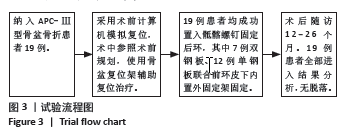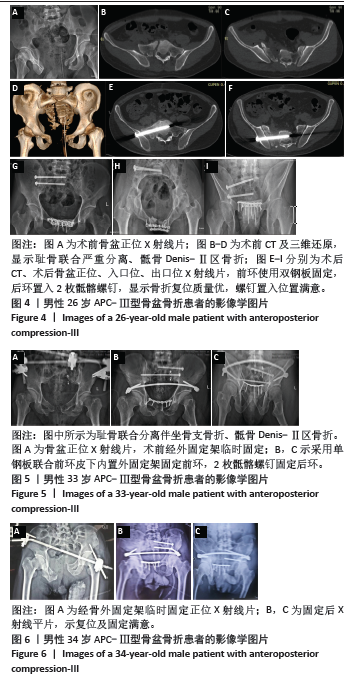[1] CHEN W, LV H, LIU S, et al. National incidence of traumatic fractures in China: a retrospective survey of 512 187 individuals. Lancet Glob Health. 2017;5(8):e807-e817.
[2] BURGESS AR, EASTRIDGE BJ, YOUNG JW, et al. Pelvic ring disruptions: effective classification system and treatment protocols. J Trauma. 1990; 30(7): 848-856.
[3] 童凯,曹生鲁,许兰伟,等.骨盆前后压缩损伤的区分及严重程度评估[J].中华创伤杂志,2019,35(5):453-459.
[4] 莫华贵,黄远翘,陈元庄,等.不稳定型骨盆骨折前环固定失效的原因分析与处理[J].中华创伤骨科杂志,2020,22(6):495-500.
[5] PASTOR T, TIZIANI S, KASPER CD, et al. Quality of reduction correlates with clinical outcome in pelvic ring fractures. Injury. 2019;50(6):1223-1226.
[6] LAI CY, LAI PJ, TSENG IC, et al. Postoperative Reduction Quality May Be the Most Important Factor That Causes Worse Functional Outcomes in Open and Closed Pelvic Fractures. World J Surg. 2022;46(3):568-576.
[7] 陈华,齐红哲,朱正国,等.骨盆外架辅助复位联合通道螺钉固定治疗Tile C1型骨盆骨折[J].中华创伤杂志,2018,34(10):919-924.
[8] 杨成亮,杨晓东,刘佳,等.骨盆解锁复位架辅助微创治疗Tile C2、C3型骨盆骨折[J].中华骨科杂志,2021,41(19):1380-1386.
[9] 陈华, 张群, 郝明,等.骨盆解锁复位装置复位不稳定骨盆后环损伤多中心研究[J].中国修复重建外科杂志,2022,36(11):1327-1334.
[10] 胡居正, 石展英, 王仁崇,等. Starr复位架联合”O”型臂导航系统治疗骨盆骨折的近期疗效[J].中华骨科杂志,2019,39(13):817-825.
[11] 李悦, 李辉, 李天宇,等.骨盆复位架在骨盆骨折闭合复位和微创固定的初步临床应用[J].创伤外科杂志,2021,23(1):5-9.
[12] CHEN H, ZHANG Q, WU Y, et al. Achieve Closed Reduction of Irreducible, Unilateral Vertically Displaced Pelvic Ring Disruption with an Unlocking Closed Reduction Technique. Orthop Surg. 2021;13(3):942-948.
[13] 肖鸿鹄, 赵春鹏, 曹奇勇,等.智能化骨折微创复位手术机器人系统治疗不稳定型骨盆骨折的随机对照研究[J].中华创伤骨科杂志,2023, 25(4):341-350.
[14] MATTA JM. Indications for anterior fixation of pelvic fractures. Clin Orthop Relat Res. 1996;(329):88-96.
[15] MAJEED SA. Grading the outcome of pelvic fractures. J Bone Joint Surg Br. 1989;71(2):304-306.
[16] RICHARD EB, CHRISTOPHER GM, THEERACHAI A. 骨折治疗的AO原则技术[M]. 第2卷. 危杰, 刘璠, 等译. 3版. 上海: 上海科学技术出版社, 2019:182-207.
[17] 齐红哲, 张伟, 李嘉琦,等.切开复位与闭合复位内固定治疗不稳定型骨盆骨折长期预后的多中心队列研究[J].中华创伤骨科杂志,2023, 25(6):485-490.
[18] 王贵, 朱仕文.骨盆骨折微创治疗技术的研究进展[J].中华创伤骨科杂志,2023,25(6):518-522.
[19] ALZOBI OZ, ALBORNO Y, TOUBASI A, et al. Complications of conventional percutaneous sacroiliac screw fixation of traumatic pelvic ring injuries: a systematic review and meta-analysis. Eur J Orthop Surg Traumatol. 2023;33(7):3107-3117.
[20] 刘志勤, 刘康, 邱尔钺,等.INFIX内置支架系统联合骶髂螺钉内固定治疗Tile C型不稳定骨盆骨折疗效观察[J].中国骨与关节损伤杂志, 2022,37(2):170-172.
[21] JäCKLE K, SPERING C, SEITZ MT, et al. Anatomic reduction of the sacroiliac joint in unstable pelvic ring injuries and its correlation with functional outcome. Eur J Trauma Emerg Surg. 2020;48(2):1491-1498.
[22] 邢顺民, 徐寅强, 方良勤,等.改良Stoppa入路在不稳定骨盆与髋臼骨折内固定术中的应用[J].中国骨与关节损伤杂志,2021,36(8):816-818.
[23] HUANG C, ZHENG W, REN YM, et al. Effect of computer virtual technique combined with pelvic reduction frame in the treatment of type C pelvic fracture. Zhongguo gu shang. 2022;35(4):323-328.
[24] 何立, 陈华, 易成腊.骨盆解锁复位架联合智能可视化系统辅助复位与固定治疗Tile C1型骨盆骨折[J].中华骨科杂志,2023,43(19):1308-1315.
[25] 李嘉琦, 陈华, 张伟,等.非透视下三维可视化技术与二维透视在不稳定型骨盆骨折复位中的应用效果比较[J].中国修复重建外科杂志,2023, 37(2):129-135.
[26] 席智杰, 舒文, 李捷,等.智能可视化系统辅助经皮骶髂螺钉内固定治疗Tile C1型骨盆骨折[J].中华骨科杂志,2023,43(19):1316-1323.
[27] ZHAO C, WANG Y, WU X, et al. Design and evaluation of an intelligent reduction robot system for the minimally invasive reduction in pelvic fractures. J Orthop Surg Res. 2022;17(1):205.
[28] 曹奇勇, 赵春鹏, 卑明健,等.智能化骨盆骨折复位手术导航定位系统在骨盆骨折治疗中的初步应用[J].中华骨科杂志,2023,43(19):1293-1299.
[29] 唐佩福.骨盆骨折手术机器人研究的现状、挑战与展望[J].中华骨科杂志,2023,43(19):1257-1260.
[30] 时保国, 吴少龙. “看病难”的空间分析:嵌入分层理论视角的中国三甲医院地理分布[J]. 甘肃行政学院学报,2019(5):94-103+28.
[31] 郭书权, 谯波, 税巍.基于虚拟现实技术的微课在骨科住院医师规范化培训中的应用[J].中华医学教育探索杂志,2022,21(5):592-595.
[32] 柳鑫, 曾参军, 卢键森,等.3D打印计算机虚拟辅助技术在髋臼骨折术前规划中的应用[J].南方医科大学学报,2017,37(3):378-382.
[33] HACKENBROCH C, FEILHUBER M, HALT D, et al. Low-Dose CT in Pelvic Imaging: Comparing Dose and Image Quality in Relation to Clinical Value in a Phantom Study. Am J Roentgenol. 2021;216(2):453-463.
[34] KIM CH, KIM JW. Plate versus sacroiliac screw fixation for treating posterior pelvic ring fracture: a Systematic review and meta-analysis. Injury. 2020; 51(10):2259-2266.
[35] 徐汉青, 徐飞, 刘彬彬,等.透视S1椎体后缘入口位对经皮骶髂螺钉置入的指导意义[J].中华创伤骨科杂志,2021,23(10):856-863.
[36] 黄晨, 郑伟, 任亚明,等.计算机虚拟技术联合骨盆复位架治疗骨盆C型骨折的疗效[J].中国骨伤,2022,35(4):323-328.
[37] LUO Y, CHEN H, HE L, et al. Displaced posterior pelvic ring fractures treated with an unlocking closed reduction technique: Prognostic factors associated with closed reduction failure, reduction quality, and fixation failure. Injury. 2023;54:S21-S27. |

